| |
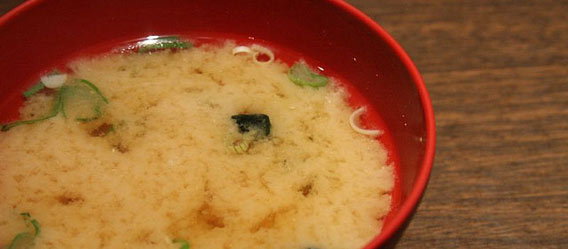 With the temperature cooling for the month of October, what better topic to cover than that of Japanese soups? Find out what some popular traditional Japanese soups are, and take a stab at making one of these delicious and nutritious traditional Japanese soups in your very own kitchen, and surprise your family and friends with the variety and richness Japanese soups can offer.
Soups can be found worldwide in a variety of culinary traditions. Often traditional soups can give a glimpse into the culinary past of a nation. This month we’ll take a look at some popular traditional Japanese soups. Staring with the most popular of them all.
Miso Soup
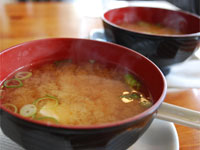 Miso soup is probably the most well known of Japanese soups worldwide. It is the popular classic Japanese soup that we are all familiar with. But while we may think that we are familiar with its taste, traditional Japanese miso soup is more complex and more varied than the staple miso soup we get at Japanese restaurants. Miso soup is probably the most well known of Japanese soups worldwide. It is the popular classic Japanese soup that we are all familiar with. But while we may think that we are familiar with its taste, traditional Japanese miso soup is more complex and more varied than the staple miso soup we get at Japanese restaurants.
Miso soup is made from stock, known as dashi, and softens miso paste that is mixed into the stock. Dashi is typically made from niboshi (dried baby sardines), kombu (dried kelp), katsuobushi (thin shavings of dried tuna), or sometimes dried shitake mushrooms.
In the United States and outside of Japan, instead of using dashi, vegetable stock is often used in place of dashi. Beyond the variation in the stock, the miso paste that is mixed into the stock to create miso soup also feature unique variety. Traditional miso soups are crafted from three different kinds of miso paste: red, white, or mixed.
Red miso is aged for a long time. It is known for its salty and sharp flavors and is a strong tasting miso. White miso is fermented for short time, and is known for its sweet and subtler taste.
Mixed miso, as its name suggests, is a mixture of various kinds of miso. There are many kinds of mixed miso, depending on the types of miso included in the mix. In general mixed miso gives a more well-rounded taste, as weaknesses of each type of miso is complemented and supplemented by others in the mixture.
Finally traditional miso soups typically feature different kinds of solid ingredients during different seasons. Ingredients may include seaweed, potatoes, mushrooms, onions, shrimp, fish, and sliced white radish.
Tonjiru
Sometimes also known as butajiru, tonjiru refers to the Japanese soup made from pork and vegetables. Tonjiru is made by stewing vegetables and thinly sliced pork in dashi stock. Dashi stock is a cooking stock or cooking broth that is widely used in Japanese cuisine. Other than being used in the creation of miso soup, and the tonjiru, dashi is also used in many broths used in Japanese noodle dishes.
Miso is also added for flavor. Seaweed, spring onions, white radish, carrot, tofu, mushroom, potato, konjac (an edible gelatin made from the root of the konjac plant), and burdock root are popular ingredients for this soup. Burdock roots are not commonly eaten outside of Japan, so finding this ingredient might be a challenge in some places, but if you are able to visit any Japanese markets in Japan towns, burdock roots can usually be found. They are a long and narrow root and is rich in potassium, magnesium, iron, inulin and cellulose.
Tonjiru is a cross between soup and “juice”, it is a hearty soup that is rich in nutrients and vitamins, and is a healthy way to satisfy one’s craving for comfort food.
Comparable to miso soup, tonjiru is a more substantial soup. Because of its hearty ingredients, the tonjiru is often eaten with rice like a main dish. It is known as the Japanese comfort food, and is very popular during the cold months of winter in Japan.
Imoni
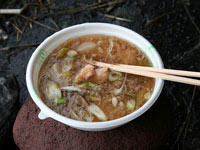 Imoni is a thick potato and meat Japanese soup popular in the Tohoku (Northeastern) region of Japan during autumn. Based on the prefecture, imoni soup can have a wide variety of taste and method of preparation. Imoni soup can contain beef, sugar and soy sauce and offer a sweet taste, or it can use miso flavoring. Imoni soup can also feature pork instead of beef depending on the prefecture. Imoni is a thick potato and meat Japanese soup popular in the Tohoku (Northeastern) region of Japan during autumn. Based on the prefecture, imoni soup can have a wide variety of taste and method of preparation. Imoni soup can contain beef, sugar and soy sauce and offer a sweet taste, or it can use miso flavoring. Imoni soup can also feature pork instead of beef depending on the prefecture.
But despite these variations, all imoni soups contain the following ingredients: taro root, thinly sliced beef or pork, konnyaku (dense jelly made from konjac plant that is grown in East Asia for starchy corm. The konjac flour is mixed with limewater and water to create a gelatin form), and soy sauce.
Particularly in Yamagata prefecture, imoni get-togethers known as imoni-kai are celebrated in autumn. Tourists and local residents alike gather on riverbanks during the festival to partake of imoni from giant iron kettles together.
Ramen Noodle Soup
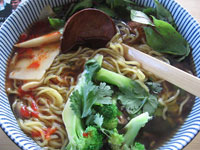 Another favorite well-loved soup dish in Japan and around the world is the ramen noodle soup. Ramen is a wheat noodle that is commonly served with different Japanese soup bases. The three most common and popular are: miso, tonkotsu and shoyu. Another favorite well-loved soup dish in Japan and around the world is the ramen noodle soup. Ramen is a wheat noodle that is commonly served with different Japanese soup bases. The three most common and popular are: miso, tonkotsu and shoyu.
Tonkotsu soup base originated from the South, from Kyushu region of Japan, and the miso soup base came from the North from the Hokkaido region.
The ramen noodle itself originated from China, and its name “ramen” came from the Chinese pronunciation “la mian” which literally translates into hand pulled noodles. While the noodles and the added ingredients certainly form a crucial component of the ramen dish, the broth is the foundation. Making ramen broth requires a lot of time and effort. Creating the broth often takes up to hours, sometimes, even days.
Other than the miso flavored broth, below are two other popular ramen broth styles:
Tonkotsu
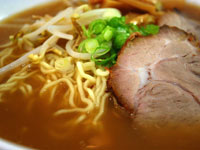 Bearing the meaning of “pig bone” tonkotsu is the milk white broth that is commonly found in Japanese ramen noodle dishes. It is a sweet tasting thick broth that is made by boiling pork bones, fats, and collagen over high heat for an extended period of time. The result is a flavorful milky soup with a silky texture. Often ramen noodles is served with this tasty broth with a topping of sesame oil. Bearing the meaning of “pig bone” tonkotsu is the milk white broth that is commonly found in Japanese ramen noodle dishes. It is a sweet tasting thick broth that is made by boiling pork bones, fats, and collagen over high heat for an extended period of time. The result is a flavorful milky soup with a silky texture. Often ramen noodles is served with this tasty broth with a topping of sesame oil.
Shoyu
Another popular broth that is paired with ramen noodles, shoyu is a clear brown broth typically made from chicken, fish, or beef and vegetables with a lot of soy sauce added for flavoring. The result is a tangy and salty broth that is subtle and light.
Warming up with Japanese Soups
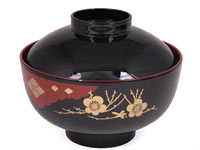 With the autumn chill rolling in, try warming up with some of these interesting Japanese soups. Recipes are available online and in cookbooks. Stock up your kitchen with some Japanese soup essentials and cook ware. This winter will be a hearty and warm one with tasty and unique Japanese soups. With the autumn chill rolling in, try warming up with some of these interesting Japanese soups. Recipes are available online and in cookbooks. Stock up your kitchen with some Japanese soup essentials and cook ware. This winter will be a hearty and warm one with tasty and unique Japanese soups.
Other than being tasty options to try out this winter, Japanese soups are also well known for their health benefits. Miso is known to be high in Vitamin B12. It is also believed that because of their fermentation process, miso contains lecithin, which lowers blood pressure.
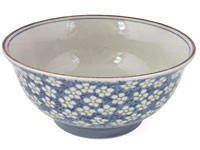 At Mrs Lin’s kitchen, we also offer a wide selection of ramen bowls, miso soup bowls , and a variety of charming soup bowls. Create and enjoy delicious Japanese soups and ramen noodle soup dishes in style with our unique and stylish Japanese dining ware. At Mrs Lin’s kitchen, we also offer a wide selection of ramen bowls, miso soup bowls , and a variety of charming soup bowls. Create and enjoy delicious Japanese soups and ramen noodle soup dishes in style with our unique and stylish Japanese dining ware.
|
|
 |
OUR 2013 NEWSLETTERS
Traditional Japanese Soups 101
Asian basics for New Apartments
Popular Japanese Characters and the Cult of Popularity
Exotic Fruit Kingdom- Journey into the World of Asian Fruits
Light Asian Snacks
Way of the Gods: Shintoism in Japan
The Chinese concept of Yin and Yang
Onsen: Japanese Hot springs—Enjoyment and Etiquette
Lunar New Year 2013: The Year of the Snake
Nabemono - Japanese Hot Pots
NEWSLETTER ARCHIVES
2013
2012
2011
2010
2009
2008
2007
2006
2005
2004
2003
2002
2001
|